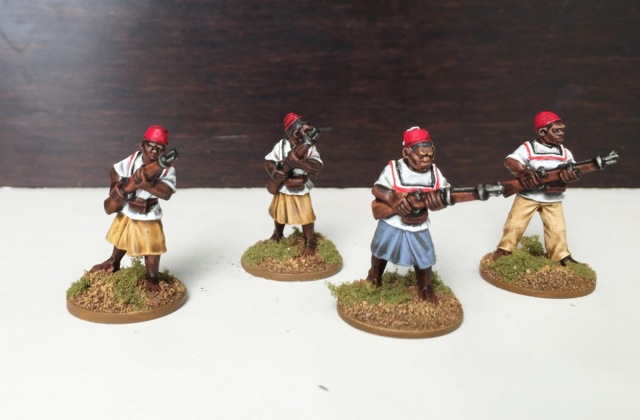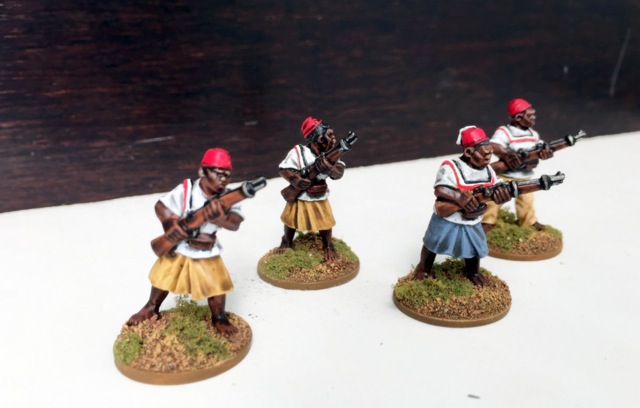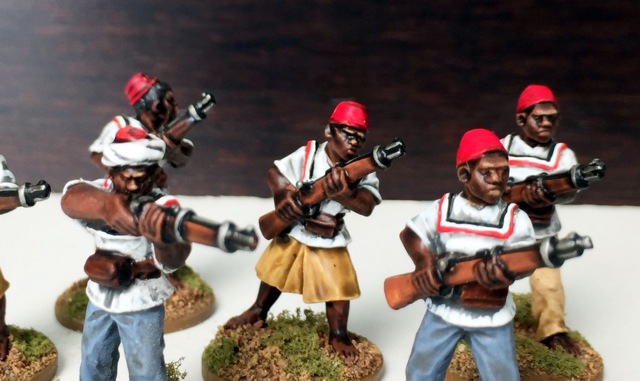
In the last two posts we focussed on the Armed Porter variety of askaris. In the Peters expedition there were askaris that would be more familiar to those with only a passing interest in such troops at the turn of the 19th century, meaning trained and organised local troops under the leadership of European officers, usually in some form of uniform…your classic ‘askari’.
In the Explorer list these other types of askaris are represented as the ‘Uniformed Askaris’ troop type that itself can be taken two ways – either as Solders or Askaris. We compared the askari armed porters in the previous post (as they could be taken as musketeer and askari types) and it will be instructional to do the same with their better organised, trained and led cousins.
In many respects the trajectory of local troop indoctrination for most organising colonialist give something of an ‘askari arc’ if you like, from the humble armed porters, to organised askaris, more heavily armed askaris and then soldier-askaris. The next step in the Rifles and Spears troop classification would put the askaris at parity with European regulars, which Wissmanntruppe Askaris achieved, completing the full spectrum of troop qualities and attributes for the widely used locally formed forces of the various powers…in our case, the Germans.
.
Ok, so what makes Uniformed Askaris what they are in the game?
.

.
Similar to the Armed Porters, Uniformed Askaris can be taken two ways – either as Solders or Askaris. For our discussion The generic Explorer list notes have been deleted and the list above reflects askaris as used by Peters in his expedition or more generally those of the German East Africa Company (DOAG). Just to recap the two types of troops (as described in R&S after ITHOA) can be;
SOLDIERS – We use this term primarily to describe other trained African troops with breechloaders. They may be equipped with similar weapons to Regulars, but lack their formal discipline. They are unlikely to be very happy about bayonet-fighting. Most such men will form part of European-led forces, although by the 1890s a few Arab and native rulers will have managed to form their own units, some of which are of comparable effectiveness. Examples are locally raised askaris accompanying most of the imperial expeditions of conquest.
ASKARIS – ”Askari” is an Arabic word meaning ”soldier”. For classification purposes in these rules, it embraces most reasonably well equipped and trained African and Arab troops armed predominantly with muzzle-loading firearms – including those employed by Europeans. The majority of native troops equipped with breechloaders are also to be found in this category, described as ’heavily-armed askaris’ as they are likely to be insufficiently trained or motivated to take proper advantage of them. Note that many of the riflemen employed by European armies, who were officially entitled ”askaris”, are classified here as Soldiers.
.
Comparison
These descriptions nicely show how both types of troops are valid for troop classification of the askaris in Peters’ expedition. The important difference is the their tactical use and the weapons now speak to a more defined role i.e. as soldiers they are now expected to function in the same manner as European soldiers …so let’s take a look at their attributes in comparison to one another;
.
Troop Type – Askaris are an Irregular troop type. This gives them four 1-action cards in the deck to activate. Soldiers however are rated as troop type Provincial. This allows them to get two 1-action cards and one 2-action card. It is the 2-action card that provides them with the ability to behave as Regular troops do, at least half of the time. This card combination shows how the less organised askaris are represented as becoming more professionalised in the game. The two-action action card can be decisive when combined with breech loading or repeating weapons as it provides an opportunity for two shots of early rifle fire.
Design note – in Rifles and Spears Provincial troops get four actions spread across three cards, unlike Muskets & Tomahawks which only gives them two cards with three actions. For the colonial period the better historical effect is achieved by allowing them the additional 1 action like all other troops otherwise organised askaris can be at a disadvantage compared to their less well trained counterparts.
Morale – Soldiers are rated as Committed which places them a notch above the usual askari morale grade of Hesitant. This embodies the effect of their generally better training and ‘standing’ compared to other indigenous troops. This gives them a good level of morale in the game and when supported by an officer or standard-bearer as well as the boost from their unit size, their ability to pass reactions tests is quite good. Coupled to their Drilled trait (see below) they become quite tough. Also worth noting is that typically Soldiers are often fighting enemies who themselves will probably not be that good at using weapons that can cause negative morale modifiers (see playsheet) which means they become quite resilient to most causes of reaction in the game.
Number – Askaris can have units of 6-12 men. Soldiers are organised along European lines and have units of 8-12 men. Not a big difference as both have an ability to stay ‘big’ (i.e. 6 models or more in a unit) which provides a morale bonus. If desired large units (12men) of Askaris can be taken to make them stay big for longer but, once again, against opponents that have a limited ability to reduce this size with png range fire this might not be the most tactically flexible. what to go. Soldiers can be formed into units of 8 at a minimum so they are a little less able to operate in smaller groups tactically unlike the askaris (6men) so there are small points of difference here, but nothing to much.
Movement – Like the difference between Musketeers and Askaris, this is where the troop’s role in the game starts to show. Soldiers have a move distance of 4″ whilst the Askaris are 5″. This means Soldiers must stay quite close together and have a slower overall movement ability when spread across their four action which is more in keeping with their role to fight in the line (i.e. 4″ per turn slower than askaris, 8″ less than Musketeers). When combined with the Soldiers other Options (below) the two troop types role in the game become clearer.
Shooting, Aggressiveness & Defence – A baseline shooting and aggressiveness rating of 5+ applies to both types. However this can be deceiving as the Soldiers Drilled trait gives then bonus in both these ratings (described below). Askaris have their 5+ defence rating which as previously described isn’t that great, though against similar troops it is adequate. The general lack of enthusiasm for the ‘bayonet fighting’ is partially reflected with a low aggression value compared to Regular troops.
Soldiers however have their defence rating increased to 4+…a good rating and comparable to European regulars generally reflecting their great training and discipline. Even though these ratings appear very similar they are in fact the great points of difference when combined with the Drilled trait.
Weapons – Both types may be armed with the trusty musket but naturally enough both may be upgraded to use a breechloader. This is virtually a ‘gimme’ for the Askaris as it is the best way to make them effective in the game. Muskets still have their place but nothing beats a breechloading rifle.
Traits – Both are rated as Auxiliaries. Like all locally raised forces this is important as it allows them to be commanded by an officer not of their type but still derive the benefits he may give them, this mostly being a morale bonus benefit in any reaction tests. It is a standard trait for all askaris to be rated as auxiliaries.
Options – Though options are limited, they are perhaps the most important of all options available to any troops in the game – training and weaponry. Soldiers, unlike Askaris, are able to take the Drilled trait. This essentially is the reason why you would take Soldiers over Askaris in the game (barring historical precedent) as the Drilled trait enables troops to use the Firing Line ability.
This ability provides several significant bonuses (and restrictions) that reflect the training troops go under (drill) to use this formation.
The basic requirement is to have 6 or more models (4 if equipped with breechloader/repeater rifles) to allow one or two rank line to be formed. The reduced model requirement for BLR/RR equiped troops accounts for the much higher volume of fire that these weapons, in even in small groups, can achieve.
Troops in firing line gain a morale boost which is a significant bonus when coupled to an officer’s ability to bump up their morale as well. This represents a +2 modifier shift on a d6 die roll which is alot.
As an aside, in melee Soldiers in firing line do not get the ability to conduct a ‘bayonet attack ‘. This is an important point of difference between Regular troops and Soldiers who both can adopt the firing line formation and share most of its benefits. This reluctance to ‘give ’em the bayonet’ reflects their lack of enthusiasm for this style of fighting .
For troops equipped with BLR/RR weapons troops in firing line they gain a +1 melee modifier in defence (this representing the last minute discipline shooting of the firing line just prior to being attacked…not the actual fighting qualities of the formation as such on the defence).
So…quite a lot going for this simple Drilled trait!
For all these benefits Drilled troops who do use firing lines do have some limitations placed on them.
As mentioned a minimum of 6 (or4) troops are needed to form up and they must do so in open terrain ie not in a any difficult going or buildings which can provide excellent cover. Behind a wall of boxes or meile bags is fine, but not inside a house. They also have a restricted arc of fire of 45 degrees left and right to their front so they do become somewhat susceptible to being flanked negating their significant frontal firepower and melee ability. In this way it can be seen that firing lines frontally and with supported flanks and equipped with muskets, but particularly BLR/RR weapons, are very tough if not to a certain degree, invulnerable.
The concentrated grouping of troops in firing line also makes them an easier target to hit. This is not usually a problem against troops equipped for hand to hand fighting but many enemies in Africa have both smoothbore and rifled weapons….so troops in firing line must use this formation judiciously lest they simply become easy targets…think Modder River.
Shooting in firing line, using volley fire, also limits target selection ie a firing line can only shoot at one target. This can cause over concentrations of fire (overkill) to the detriment of more pressing enemy threats. Whilst not usually a problem, against a well disciplined enemy force this can result in fire being ‘drawn off’ whilst the enemy seek advantage through flanking movements.
Coupled to the advantages/disadvantages of the Drilled trait, the ability to take a breechloading weapon wI’ll provide a significant ‘firing line formation multiplier’. Breechloading and repeater armed troops in firing line are a formidable opponents….take note!
From the above it becomes clear that when you take drilled askaris as a ‘Soldier type’ there are substantial increases in capability over ‘simple Askaris’. Whilst both types benefit from the use of the Breechloading rifle, the Soldiers in firing line maximise the weapon’s capability in Rifles & Spears, just like in real life.
Conveniently, all these attributes are placed in the firing line traits section of the rules and noted on the play sheet for ease of use.
Points – Askaris cost 4 points and Soldiers, due to their host of special abilities described above, cost 5 points.
.
Summation
So it can be seen that not all ‘askaris’ are made equal in Rifles & Spears. You have the option to portray two types of askaris in your force or a mix. Some may rely on their natural native skills ‘adapted to traditional tactics’ providing them with bonuses in broken ground whilst Askaris, more accustomed to be ‘up gunned’ and fighting in the line, will be eschew the traditional style and will be more use adopting a fighting role akin to European style troops fighting in line, often with better equipment – the choice is yours!
.
◊
Here are some photos of the DOAG askaris. These troops can be used for early Wissmantruppe askaris and those foreign par of Carl Peters’ Emin Pasha expedition – they wear virtually the same uniform…they are the ‘Uniformed Askaris’ described above. .
.
.
.
.
.
.
.
.
.
.
.
.
.
.
.
.
.
.
.
.
.
.
.
.
.
.
.
.







